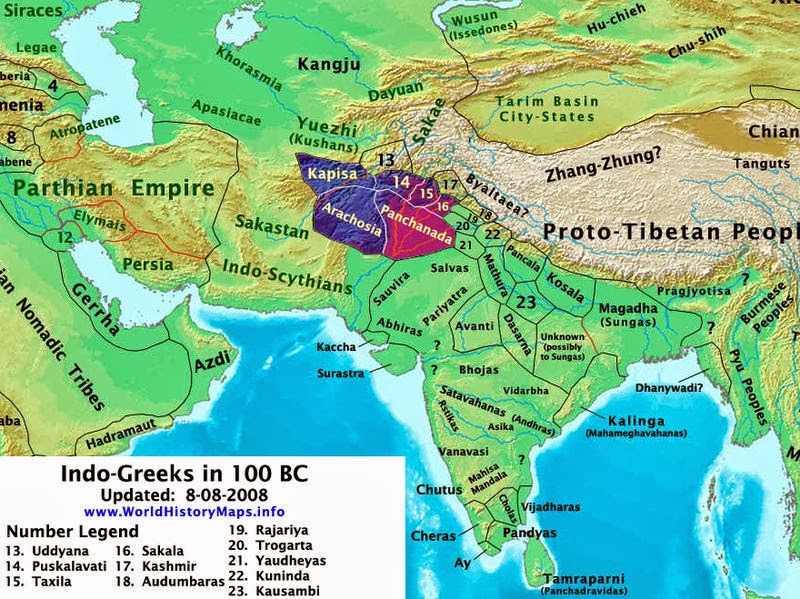Ai Khanoum (Alexandria on the Oxus )
Ai Khanoum ('Moon Lady' in Uzbek) (an alternative translation is "Face in the Moon", because people over there recognize a female face on the moon).
( Ai- Khanoum) is presumed to be (Alexandria-Oxiana), founded by Alexander.
(Ai Khanoum) and was excavated by French archaeologists and looks surprisingly like a Greek city, including temples, a heroön, palace, colonnaded courts, city wall, gymnasium (sport school), houses, Corinthian columns, free-standing statues, and a theater wth 5,000 seats. The citadel, which is on a 60 m high loess-covered natural mound, has not been investigated yet, although it must have had massive walls and high towers.
Cybele dish from Ai Khanum.
Among the finds are Greek and Indian coins, several inscriptions, sundials, jewelry, a famous plate showing the Phrygian goddess Cybele, the Greek god Helios,
Alexandria is situated on the confluence of the mighty Amudar'ya (the ancient Oxus) and the Kokcha. Across the river is a spectacular wall of steep rocks. The city became rich because it controlled the trade in lapis lazuli, but it was also situated on the Silk road
Ai Khanum is an example of genuine, solid Hellenistic city with Greek architecture and institutions, a huge majestic structure with the characteristic central avenue, an Acropolis, Temple of Zeus, Palace, Theatre, Gymnasium dedicated to Hercules, Library, public fountains, statues, Greek pillars, and philosophical epigrams carved on the city's monuments, based on Delphic maxims. The city cleverly blended the local elements with the Hellenic civilization.
Numerous artifacts and structures were found, pointing to a high Hellenistic culture, combined with Eastern influences. It has all the hallmarks of a Hellenistic city, with a Greek theater, gymnasium and some Greek houses with colonnaded courtyards. It seems the city was destroyed, never to be rebuilt, about the time of the death of the Greco-Bactrian king Eucratides around 145 BC.
The second great center of Hellenistic civilization was Bactria, in Central Asia. The Greco-Bactrian and Indo-Greek kingdoms developed there, with forty Greek kings ruling the region in succession, as far deep inside India, for three centuries. The Greek kings established some Greek cities and introduced the Greek coins in these areas (some of the attic type) with Greek gods on the rear. Thousands of coins were discovered showing the Greek cultural influence, the high level of civilization, the wealth of the area and the Hellenic influence on the cultural and economic life of the local people.
THE ancient site of Ai Khanoum was for the past 10 years the target of systematically planned illicit digs. This is little less than tragic for our contemporary understanding of ancient cultural interactions. One of the most significant contributions towards an understanding of Greek presence in Bactria was made through the Ai Khanoum excavations led by French archaeologists under Prof. P. Bernard.
The ruins of Ai Khanoum stand on the left bank of the Oxus river at its meeting point with its tributary, the Kokcha. This triangular area at the confluence of the Oxus and the Kokcha was a strategic choice the Greeks made. It was a well-placed military outpost to control the eastern territories of ancient Bactria. The topography of the site, with a natural acropolis about 60 m higher than the surrounding areas and protected by the two rivers from the west and the south, made it an ideal choice for the Greek city planners. The residential quarters and public buildings - namely the gymnasium, the temple, the fortifications, the royal palace and the administrative apparatus - were built in the lower part of the site, which was less exposed to the winds than the acropolis.
The discoveries made at Ai Khanoum by the French archaeologists demonstrate how the Greek artists of Ai Khanoum not only remained attached to the Greek traditions but also in some ways perpetuated a classical style. For example, the mosaic floor of the palace bathroom displaying dolphins, sea horses and sea monsters was made by setting a field of dark red pebbles, instead of the square-cut stones of the later style.



